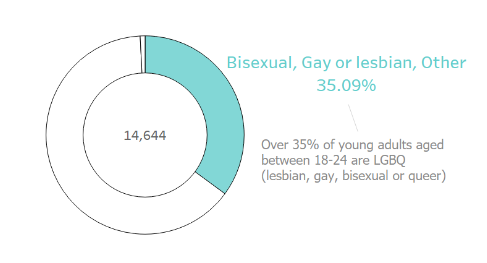New Tool by System Change Partners Shows Over One Third of Young Adults in the United States are LGBTQ+
Liz Harding Chao I June 9, 2023
Liz Harding Chao I June 9, 2023

With the Human Rights Campaign recently declaring a state of emergency for LGBTQ+ people in the US, it is more important than ever to know the scale of the population that anti-LGBTQ+ laws and discriminatory practices are targeting. System Change Partners, a LGBTQ+ and People of Color owned data and technology consulting firm, released a new tool (“We Are Here: LGBTQ+ Identities in the US“) that shows the prevalence of LGBTQ+ identities, by state and age group, across the United States (US).
Over 35% of young adults aged between 18-24 are LGBQ (lesbian, gay, bisexual or queer) and 7% are gender expansive (trans, non-binary or something else). Use the dashboard and filter by state and age group to see the prevalence of LGBTQ+ identities in your state.
According to The Brookings Institute’s recent study on the prevalence of LGBTQ+ identities, LGBTQ+ identification has doubled over the past decade, but data on this population remains limited. Each of the national public datasets that Brookings examined showed an increase in the LGBTQ+ population over time, with the increase being mostly driven by young adults. The Brookings report shows that according to the National Health Interview Survey (NHIS), in 2013 around 4% of young adults identified as lesbian, gay or bisexual (LGB), which increased to 9.5% in 2021. However, our analysis of 2022 Household Pulse Survey (HPS) data shows that at least 35% of young adults nationally identify as lesbian, bisexual, something else, or questioning. This means that previous surveys are a vast undercount.
The HPS is a 20-minute online survey that started in 2020 and studies how the coronavirus pandemic is impacting households across the country socially and economically. Participants are asked questions about core demographics as well as a list of other topics including food and housing security, physical and mental health, employment, and education. Participants are chosen via their addresses which are scientifically selected to represent the entire population.
The HPS asks one question about sexual orientation and two about gender. We separate our analysis of sexual orientation and gender identity (SOGI) because these questions are asked separately in the survey and they encompass different (but often intersecting) identities. The question about sexual orientation asks respondents: “Which of the following best represents how you think of yourself?” The options are: 1) gay or lesbian; 2) straight, that is not gay or lesbian; 3) bisexual; 4) something else; and 5) I don’t know. For the purposes of our analysis we classified young adults who answered gay or “lesbian,” “bisexual,” “something else,” and “I don’t know” as part of the LGBQ community. We included young adults who selected “something else” because there are many other identities not included in the survey options, including queer, pansexual, asexual, demisexual etc. We included young people who answered “I don’t know” as part of the “Q” in LGBQ – “questioning.”
A two step approach is used to identify the respondent’s sex that they were assigned at birth and the gender they now identify with. The first question is: “What sex were you assigned at birth, on your original birth certificate?” The options are “male” and “female”. Then respondents are asked: “Do you currently describe yourself as male, female or transgender?” The options are 1) male; 2) female; 3) transgender; and 4) none of these. We categorized “male” and “female” as cisgender. We also created a gender expansive category with those who identified as “transgender” and “none of these.”
The HPS only includes people over the age of 18 and we narrowed our analysis to the 2022 data sets (Weeks 41-52).
There were 555 total respondents in WA between the ages of 18 to 24. 41% of total respondents identified themselves as lesbian, gay, bisexual, something else or questioning (Figure 1).
Sexual Orientation of Young Adults (18-24 yrs) in Washington State (2022)
Source: Author’s own calculations. Household Pulse Survey 2022
– Liz Harding Chao